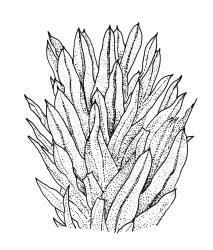Vitt & Ramsay’s (2006) generic description was modified in preparing the following description.
Plants medium-size to robust, forming dense red-brown mats or cushions on bark or sometimes on rock. Stems creeping, with numerous ascendant and usually forked branches, less often unbranched, densely beset with brick-red, much-branched, and papillose rhizoids, in cross-section with thick-walled outer cells and no central strand. Branches ascendant, usually branched by forking, densely covered with rhizoids. Branch leaves imbricate and spirally twisted around the branch when dry (in N.Z. species), erect-spreading to spreading and ± rugose when moist (sometimes squarrose in non-N.Z. spp.), oblong or oblong-lanceolate, acute, mucronate or cuspidate at apex (sometimes aristate in non-N.Z. species), strongly keeled; margins reflexed below, plane and entire above (in N.Z. species); upper laminal cells elliptic to rounded-quadrate, smooth, thick-walled, arranged in oblique rows, gradually merging into the cells of the lower leaf, which are more elongate, porose, unevenly thickened, and often papillose or prorate; cells at basal margins not differentiated. Costa strong, ending just below leaf apex to excurrent, with two adaxial guide cells and abaxial stereids.
Phyllodioicous. Perichaetia terminal, but often appearing lateral due to innovation, the perichaetial leaves longer than vegetative, but otherwise not differentiated in N.Z. species, enclosing numerous, golden, 5–6-celled paraphyses. Male plants dwarf and epiphyllous on ♀ plants. Setae elongate (in N.Z. spp.) or sometimes short, straight, or slightly curved, smooth, sinistrorse in N.Z. species; capsules long-exserted and cylindric (in N.Z. spp.), ribbed (strongly 8-ribbed in N.Z. species) or smooth; exothecial cells thick-walled, mostly short-oblong, in N.Z. species not in clearly differentiated vertical ranks; stomata superficial, numerous in lower portion of urn; annulus weakly differentiated or absent; operculum slenderly rostrate from a conic base. Peristome double; exostome teeth 16, linear, mostly reflexed when dry; endostome with 16 or 32 irregular, broad, and blunt segments that are ½–⅔ the length of the exostome. Calyptra mitrate-campanulate, large and enclosing the entire developing capsule, neither plicate nor hairy, with usually 4–6 broadly triangular and clasping lobes at base. Spores 1-celled, isomorphic, coarsely papillose.
Schlotheimia is a large genus (c. 130 species fide Vitt & Ramsay 2006 and Brotherus 1925), predominantly distributed in the southern hemisphere. Vitt et al. (1993) considered Madagascar and eastern South America to be centres of diversity. Only two species occur in N.Z. and two others occur in Australia. Schlotheimia funiformis has smooth capsules and strongly differentiated perichaetial leaves and occurs in Qld and N.S.W. The widespread eastern Australian S. brownii is closely related to S. knightii but differs by appearing dull, with leaves more strongly rugose and more strongly spiralled around the branches when dry; it has mostly smooth basal laminal cells. Schlotheimia brownii could well be discovered in N.Z. Vitt et al. (1993) recognised five species for western Malesia, with three of those species endemic to New Guinea.
The large, campanulate, smooth calyptrae, which have triangular and clasping lobes at their base, are an obvious feature of this genus. The N.Z. species are very often fruiting and hence the calyptrae, together with the lustrous and twisted leaves and the abundant brick-red rhizoids are useful characters that permit recognition in the field. Under the microscope the arrangement of the smooth and thick-walled upper laminal cells in oblique rows are characteristic.
Vitt (1989) provided SEM micrographs of the N.Z. species, including the peristome and spores, and more detailed descriptions than are given here.
| 1 | Branch leaves stoutly cuspidate; costa of branch leaves excurrent, completely filling a long and stout cusp; cells of the lower lamina nearly smooth or weakly prorate on the upper abaxial surface | S. campbelliana |
| 1' | Branch leaves mucronate; costa of branch leaves ending in or just below an apical mucro; cells of the lower lamina usually strongly prorate on the upper abaxial surface | S. knightii |
| Category | Number |
|---|---|
| Indigenous (Endemic) | 2 |
| Total | 2 |




